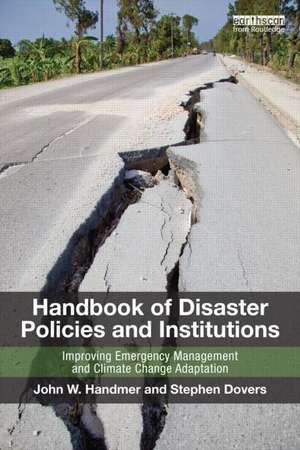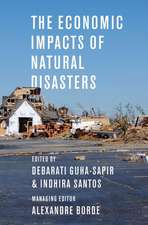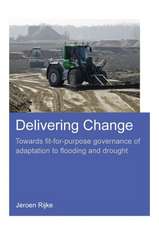Handbook of Disaster Policies and Institutions: Improving Emergency Management and Climate Change Adaptation
Autor John Handmer, Stephen Doversen Limba Engleză Hardback – 8 ian 2013
This updated and revised second edition includes new coverage of climate change adaptation, which has rapidly become central to disaster and emergency planning and management. This is an essential handbook for practitioners across the world seeking to improve the quality, robustness and capacity of their disaster management mechanisms.
| Toate formatele și edițiile | Preț | Express |
|---|---|---|
| Paperback (1) | 496.48 lei 6-8 săpt. | |
| Taylor & Francis – 4 ian 2013 | 496.48 lei 6-8 săpt. | |
| Hardback (1) | 1112.90 lei 6-8 săpt. | |
| Taylor & Francis – 8 ian 2013 | 1112.90 lei 6-8 săpt. |
Preț: 1112.90 lei
Preț vechi: 1357.19 lei
-18% Nou
Puncte Express: 1669
Preț estimativ în valută:
212.96€ • 222.80$ • 176.90£
212.96€ • 222.80$ • 176.90£
Carte tipărită la comandă
Livrare economică 02-16 aprilie
Preluare comenzi: 021 569.72.76
Specificații
ISBN-13: 9781849713504
ISBN-10: 1849713502
Pagini: 216
Ilustrații: 20 b/w images, 15 tables and 5 line drawings
Dimensiuni: 156 x 234 mm
Greutate: 0.49 kg
Ediția:Revizuită
Editura: Taylor & Francis
Colecția Routledge
Locul publicării:Oxford, United Kingdom
ISBN-10: 1849713502
Pagini: 216
Ilustrații: 20 b/w images, 15 tables and 5 line drawings
Dimensiuni: 156 x 234 mm
Greutate: 0.49 kg
Ediția:Revizuită
Editura: Taylor & Francis
Colecția Routledge
Locul publicării:Oxford, United Kingdom
Public țintă
Postgraduate, Professional, and Professional Practice & DevelopmentCuprins
Introduction Part 1: Constructing the Problem 1. The Nature of Emergencies and Disasters 2. The Nature of Policy and Institutions Part 2: Constructing the Response 3. A Policy and Institutional Framework for Emergencies and Disasters 4. Owning the Problem: Politics, Participation and Communication 5. Framing the Problem: Identifying and Analysing Risk 6. Responding to the Problem: Policy Formulation and Implementation 7. Not Forgetting: Monitoring, Evaluation and Learning 8. Institutional Settings for Emergencies and Disasters: Form, Function and Coordination Part 3: Constructing the Future 9. Future Prospects
Recenzii
‘This is a terrific book. Handmer and Dovers make a much needed and very welcome foray into the scant world of emergency management policy. The addition of the climate change dimension adds to its compelling argument and makes this book necessary reading for all involved in any aspect of emergency management today.’ – Naomi Brown, Chief Executive Officer, Australasian Fire & Emergency Service Authorities Council, Australia
‘An essential companion for anyone seeking to understand the policy context of disaster management. This new edition is especially welcome because it engages fully with the emerging thinking on the intersection of disaster management and climate change adaptation. Policy-making for disaster management also addresses the climate change adaptation challenge, making this book an important resource for those working in both adaptation and disaster management.’ – Jean Palutikof, Professor and Director, National Climate Change Adaptation Research Facility (NCCARF), Griffith University, Australia
'Handmer and Dovers successfully address the hot issues, taking into account local beliefs and indigenous knowledge and covering the areas of weakness we face in the least developed countries. This book is good guidance… I am very glad to have a copy of the 2nd Edition' – Ismail Fadl El Moula Mohamed, Director, Disaster Management, Sudan Meteorological Authority, Sudan
Praise for the first edition
'Too much emergency response to disasters has the hallmarks of panic or the deployment of immediate tactics without a strategic vision. This book is a significant contribution to seeking to correct this tendency. It does this admirably, by emphasizing both the practical and the tactical within a strong strategic framework that should help to make emergency response both better and more sustainable.' – Edmund Penning-Rowsell, Head, Flood Hazard Research Centre, Middlesex University, UK
'In this timely and insightful book, Handmer and Dovers develop a systematic understanding of the policy processes and frameworks needed to set the foundations for success when hazards threaten. It will be highly appreciated by policy makers and practitioners in rich and poor countries alike.' – Reid Basher, Coordinator, Policy and Inter-Agency Coordination, UN International Strategy for Disaster Reduction, Australia
'Emergency management, public policy and institutional settings are inextricably linked but the interactions are poorly understood. Handmer and Dovers have provided new and perceptive insights which will have far-reaching influences on understanding and future directions. I wish this book had been available when I was head of Australia's federal emergency management agency.' – Alan Hodges, AM, Former Director General Emergency Management Australia
'This book is a must-read for anyone who hopes to understand and influence emergency policy. Covering the nature of emergency management and the complex institutional framework within which it operates, the authors' comprehensive treatment of the subject is learned, internationally relevant and, yes, passionate.' – Paul Gabriel, Manager, Emergency Management Policy, Office of the Emergency Services Commissioner, Melbourne, Australia
'This is a fresh, invigorating and above all challenging look at emergency management. It takes a big-picture view, going beyond mere 'disaster events' to explore the links between emergency management and sustainability in the contexts of institutions and policy. All those who have leadership roles in the field should read it carefully: it will re-shape the way they approach their task.' – Chas Keys, former Deputy Director General of the New South Wales State Emergency Service, Australia
‘An essential companion for anyone seeking to understand the policy context of disaster management. This new edition is especially welcome because it engages fully with the emerging thinking on the intersection of disaster management and climate change adaptation. Policy-making for disaster management also addresses the climate change adaptation challenge, making this book an important resource for those working in both adaptation and disaster management.’ – Jean Palutikof, Professor and Director, National Climate Change Adaptation Research Facility (NCCARF), Griffith University, Australia
'Handmer and Dovers successfully address the hot issues, taking into account local beliefs and indigenous knowledge and covering the areas of weakness we face in the least developed countries. This book is good guidance… I am very glad to have a copy of the 2nd Edition' – Ismail Fadl El Moula Mohamed, Director, Disaster Management, Sudan Meteorological Authority, Sudan
Praise for the first edition
'Too much emergency response to disasters has the hallmarks of panic or the deployment of immediate tactics without a strategic vision. This book is a significant contribution to seeking to correct this tendency. It does this admirably, by emphasizing both the practical and the tactical within a strong strategic framework that should help to make emergency response both better and more sustainable.' – Edmund Penning-Rowsell, Head, Flood Hazard Research Centre, Middlesex University, UK
'In this timely and insightful book, Handmer and Dovers develop a systematic understanding of the policy processes and frameworks needed to set the foundations for success when hazards threaten. It will be highly appreciated by policy makers and practitioners in rich and poor countries alike.' – Reid Basher, Coordinator, Policy and Inter-Agency Coordination, UN International Strategy for Disaster Reduction, Australia
'Emergency management, public policy and institutional settings are inextricably linked but the interactions are poorly understood. Handmer and Dovers have provided new and perceptive insights which will have far-reaching influences on understanding and future directions. I wish this book had been available when I was head of Australia's federal emergency management agency.' – Alan Hodges, AM, Former Director General Emergency Management Australia
'This book is a must-read for anyone who hopes to understand and influence emergency policy. Covering the nature of emergency management and the complex institutional framework within which it operates, the authors' comprehensive treatment of the subject is learned, internationally relevant and, yes, passionate.' – Paul Gabriel, Manager, Emergency Management Policy, Office of the Emergency Services Commissioner, Melbourne, Australia
'This is a fresh, invigorating and above all challenging look at emergency management. It takes a big-picture view, going beyond mere 'disaster events' to explore the links between emergency management and sustainability in the contexts of institutions and policy. All those who have leadership roles in the field should read it carefully: it will re-shape the way they approach their task.' – Chas Keys, former Deputy Director General of the New South Wales State Emergency Service, Australia
Descriere
This updated and revised second edition includes new coverage of climate change adaptation, which has rapidly become central to disaster and emergency planning and management. This is an essential handbook for practitioners across the world seeking to improve the quality, robustness and capacity of their disaster management mechanisms.





















